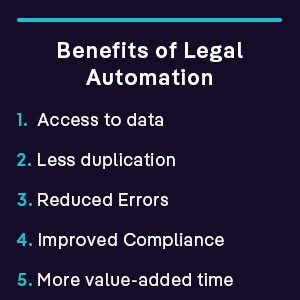In-house General Counsels (GCs) and their teams’ roles have changed, along with the environment in which they work. GCs (and Chief Legal Officers, or CLOs) are no longer just the “head lawyer” — in-house lawyers are now responsible for so much more, such as:
- Globalization of trade and information exchange
- Strategic partner with senior-level staff
- Brand reputation management
- Technology and data security
- Greater corporate governance
- Enhanced contract process productivity and efficiency
- Cost-saving efforts
- Administrative tasks
Simultaneously, legal teams are faced with copious amounts of legal requests, under-staffed teams, ever-changing regulations, and outdated, siloed technology. There simply aren’t enough hours in a day to continue producing quality work under all of these daily pressures. How can GCs and legal teams respond to these demands efficiently and effectively? Legal Automation.
Legal Automation
Legal automation is leveraging software and technology to streamline, manage, and execute legal tasks or workflows while creating efficiencies and mitigating risk. With in-house lawyers tasked to do more with less – faster and better – automation becomes an imperative resource. Automating manual, mundane, or routine responsibilities provides lawyers and legal teams more time to focus on high-level responsibilities, helps reduce human error, eliminates duplicated work, and enhances enterprise-wide collaboration. According to a Gartner survey, about one-quarter of respondents said that they increased their speed by more than 50 percent after automating some aspects of their legal practices.
Legal automation benefits both legal and business users, such as:
- Access to data: Share and search data across the company, creating better visibility and analysis opportunities.
- Less duplication: Streamline workflows to avoid duplication and ensure consistency across the enterprise.
- Reduced errors: Enforce rules and parameters to safeguard against human errors that can turn into major risks.
- Improved compliance: Adhere to pre-specified industry, regulatory, and legal requirements by alerting users to compliance issues.
- More value-added time: Work faster, smarter, and improve job satisfaction by eliminating repetitive, non-billable work.
Automate In-house Legal Requests
A McKinsey study estimated that nearly a quarter of the work that is currently performed by attorneys could be automated using available technology. One valuable component of that is in-house legal requests.
Legal request. Legal matter intake. Legal triage. They can be quite time-consuming and disorganized if not managed correctly. Historically, in-house legal requests have been done manually through emails, phone calls, applications like Teams, and spreadsheets. Unfortunately, these means often lack the necessary information to start and complete a matter. This triggers back-and-forth communication between parties that can be difficult to track and impossible to share across the company. The results? Erroneous and duplicative data entry, missed deadlines, slow delivery times, and a lot of headaches along the way.
Legal request automation optimizes the process by securely capturing the right details, every time, and allows you to collaborate, track, and complete a request on time. Even better, you can measure key metrics regarding the department’s workload to demonstrate your team’s value with key business stakeholders. How does it work?
1. Legal request made:
Organizations customize a secure matter intake form that asks all of the necessary questions and details required to adequately assign and begin work on a matter, question, or contract. This single point of contact allows any internal business user or outside counsel access to the intake form, ensuring consistency and accuracy and connecting legal to the enterprise. Customized workflows can be created to prompt additional questions or request documents that will assist in the process.
2. Legal receives request:
Once the form is submitted, it is automatically analyzed for key details that will appropriately route it to the correct legal team member. Type of matter, important deadlines, and other data helps assign it properly. Automated emails, confirming request receipt, can be generated to keep everyone involved on the same page and up-to-date on progress. For common contracts, such as NDAs, the system can even produce an entire contract based on the information provided. This automated process is created by back-end workflows.
3. Legal resources allocated:
Once an attorney or other legal team member is assigned, it is often necessary to involve other pertinent resources. Users can identify additional resources that will help streamline the case, allowing transparency along the way.
4. Communication/Collaboration:
Automated legal intake allows internal and external stakeholders to communicate more efficiently, using the same system with total visibility. Calendar events, notifications, and tasks are managed through the system and invested parties are able to view the progress and/or status of their case, or address bottlenecks, in real-time.
5. Case completed
Completed cases hold important data that can be analyzed, tracked for trends, and predicting future outcomes. System data can show from which department matters originate, what is in progress, on hold, or completed, and how quickly matters are processed. This insight helps demonstrate value for the legal team, optimize workloads, and make potential headcount adjustments based on hard facts, not guesses or assumptions.
Automating In-house Legal Requests with ContractPodAi
ContractPodAi’s new Legal Intake application leverages the best-in-class capabilities of our market-leading Contract Lifecycle Management (CLM) solution to bring legal request automation – from a simple question to a complex matter – to your team. Not only is it highly configurable to your law department’s operations, implementation can be rapid and scale with your team’s needs.
Your legal team will quickly notice enhanced tracking, improved productivity, data-driven efficiency, and increased job satisfaction. And even better, the entire organization will benefit by getting business done faster, with total visibility and transparency throughout the workflow. If you want to learn more about our Legal Intake application, contact us today to speak with one of our legal digital transformation experts.










